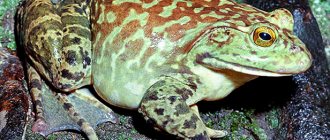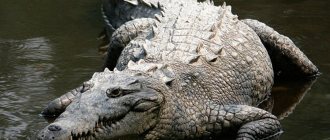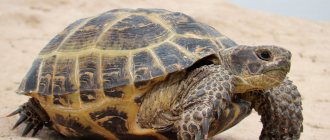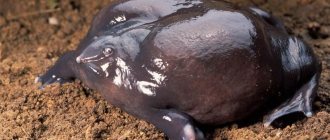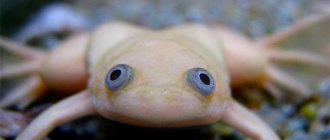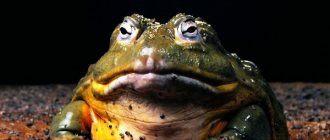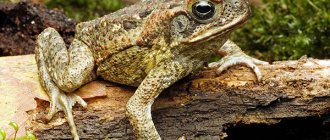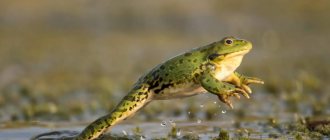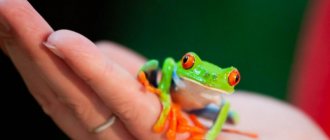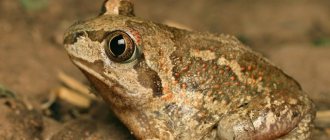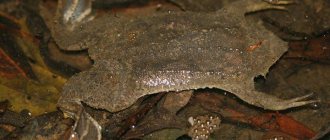Tool for combing the hair of cats and dogs My Rules (deshedder, comb, slicker) size M
711 ₽ More details
History of Russia for children. Book Butromeev V.P. | Butromeev Vladimir Petrovich
888 ₽ More details
Internal filters for aquarium
Every person has seen frogs or lizards at least once in their life. They can be found near ponds and in shady, damp places. Many people mistakenly believe that these two living creatures are relatives and belong to the same biological group. This is absolutely false. Characteristic features and distinctive features will help you figure out what class the frog belongs to, whether it is an amphibian or a reptile.
Many people wonder if lizards and frogs belong to the same class, because in some ways they are similar
Description of the class Amphibians
Amphibians are very primitive land animals. The class name reflects the main distinguishing feature of the Amphibian class. In their development cycle they necessarily have a stage of living in water. Adult animals spend almost all their time on land, but reproduction and development of larvae is possible only in water.
Therefore, every spring frogs lay their eggs in puddles and ponds, where tadpoles will subsequently grow. The skin of Amphibians is covered with mucus and is always moist. This plays a vital role, since respiration in this group of animals largely occurs through the skin. Only 30% of the oxygen absorbed comes from the lungs.
https://youtube.com/watch?v=ExakmU_RaVA
The Amphibian class is divided into 3 divisions:
- detachment Tailless;
- detachment Tailed;
- Legless squad.
By the name of the squad you can judge which part of the body is missing from each group. A representative of the Legless Ones is an interesting creature that resembles a snake - a worm. Newts belong to the order Caudates. Well, frogs occupy an honorable place among tailless amphibians. They can also include toads.
Newts and salamanders are tailed amphibians, probably all misconceptions are due to these representatives of amphibians
Tadpoles are the larvae of amphibians. They are very different from adult animals, both externally and internally. Initially, tadpoles have no limbs. They use their tail to move. Breathing is exclusively through gills, since they do not go onto land. They feed mainly on algae.
As the tadpole grows, metamorphoses begin to occur in the body. First of all, the limbs begin to form. The back ones grow first, then the front ones. The tail is preserved almost until the very end. Horny teeth appear in the mouth, so the type of feeding gradually changes from a filter feeder to a predator. The final stage is the formation of the lungs and the appearance of the second type of breathing.
What are the meanings of amphibians in nature?
Amphibians are of great economic importance: the meat of certain species is consumed by humans. ... Other species of animals also feed on them. In addition, by eating invertebrates, amphibians regulate the number of blood-sucking and other harmful species.
Interesting materials:
How was the country of Ukraine formed? How is a country's external debt formed? How to determine by barcode in which country a product was produced? How to find out the country of the perfume manufacturer using the barcode? How did the country of Ukraine appear? How to change the App Store to another country? How to change the country on iPhone IOS 14? How to change country on Samsung? How to change the country in a YouTube trend? How to change country?
Reptile class
Reptiles are a large group of terrestrial vertebrates. These include lizards, snakes, crocodiles and turtles. During the Carboniferous period, Reptiles flourished and dominated. The planet witnessed the heyday of the era of dinosaurs, which are typical representatives of this class.
In fact, lizards are more advanced and are reptiles
Compared to the Amphibia, this is a more progressive group. In their life cycle there is no connection with water, breathing becomes completely pulmonary. The skin is dry and covered with horny scales. One of the primitive features remains the absence of a constant body temperature.
The class Reptiles is divided into the following orders:
- detachment Beakheads;
- order Scaly;
- squad Crocodiles;
- Turtle squad.
There are no questions with representatives of the Crocodiles and Turtles groups. The Scaly group includes lizards and snakes, while the Beaked group has only one representative - the tuateria.
Reproduction and lifespan
Frogs breed
, laying eggs in the water, and its quantity is truly enormous and amazing, sometimes reaching up to 20 thousand eggs at a time. Grass and pond frogs lay up to hundreds of eggs, which are large lumps. Sometimes females do this in groups.
The eggs hatch into tadpoles. These creatures are frog larvae, breathe through gills, can exist and move only in an aquatic environment, and have a tail. The transformation of eggs into tadpoles takes from 7 to 10 days.
Over time, the tadpoles begin to change greatly and go through a stage of metamorphosis, which lasts about 4 months. First, their hind limbs grow, then their forelimbs, then the tail-rudder disappears, and the tadpoles turn into adults with the distinctive features of their type of frogs, ready for life on earth. At three years old, frogs become sexually mature.
The photo shows frog eggs
Measuring the lifespan of frogs is quite difficult. But according to scientific research, using measurements of the growth of the phalanges of the fingers by season, data were obtained that allowed us to believe that adult individuals are able to live up to 10 years, and taking into account the tadpole stage, up to 14 years.
What types of animals are there?
Animals include insects, fish and birds
.
Insects
are animals that have six legs (three pairs).
Fish
are aquatic animals whose bodies are covered with scales.
Birds
are animals whose bodies are covered with feathers.
Animals (mammals)
are animals whose bodies are covered with hair and which feed their young with milk.
To a special group of animals - amphibians
- include frogs and toads.
Another group - reptiles
- includes snakes, lizards, turtles, and crocodiles.
Use pencils of different colors (of your choice) to highlight the names of animals from different groups. Perch, bumblebee, bullfinch, catfish, giraffe, ant, hedgehog, owl.
In the frame, decipher the symbols, that is, show what color each group of animals is indicated by.
| Insects | Fish | Birds | Animals |
Use schematic drawings to depict the main features:
Explain your drawings.
The main characteristics of insects are six legs, fish are scales, birds are feathers, and animals are fur.
Give examples of animals (at least three in each group). To select examples, use the atlas - the determinant “From Earth to Sky”.
a) Insects: May beetle, ground beetle, dung beetle, wasp, bumblebee, bee, admiral butterfly, mourning bird, bluebird b) Birds: magpie, nutcracker, jay, sparrow, stork, pigeon, thrush, starling, eagle, cuckoo, cockatoo, canary , wagtail c) Animals: roe deer, wild boar, chipmunk, vole, dormouse, wood mouse, marmot, gopher, wolf, leopard, hare, fox
Nadya really liked her mom’s assignment about plants. And she came up with something similar for you, but about animals. The names of four groups of animals are hidden here. Find them and color the squares with letters with pencils of different colors.
Compare the sizes of the animals shown in the picture. In the red squares, number the animals in order of increasing size. Number the blue squares in order of decreasing size. Ask your deskmate to check on you.
Indicate with arrows which groups these animals belong to.
In the book "Green Pages" read the story "Similar, but different." Find out how a frog and a toad are similar and different. Write it down.
Comparison of frog and toad
Similarities:
- frogs and toads are amphibians, i.e. live on land and water
- both swim beautifully
- spawn in the water
- horizontal pupil of the eye
Differences:
- Frogs have moist skin, while toads usually have dry and warty skin.
- toads walk, and frogs jump, pushing off with their strong hind legs
- The toad's hunting object is insects crawling and running on the ground, while the frog's prey is mainly flying insects. Because of this, the toad's head is tilted closer to the ground, while that of frogs is raised up
- The toad has no teeth; the frog has small teeth on the upper jaw.
- the frog lives near water bodies, and the toad lives far from water bodies. They live in the forest and come to the water only to have offspring.
- The frog is diurnal, and the toad hunts at night.
- The appearance of the caviar is different: in the frog it is in the form of lumps, and in the toad it is in the form of cords.
- Let's repeat the rules of working in a group.
- We talk in a low voice.
- We work together.
- We listen and hear our comrade.
- There are texts on your tables. . Listen to the task.
1 group. Reads the text. Finds out the name of the group of animals to which the frog belongs. Using a dictionary and textbook, page 51, explain the name of this group of animals.
2nd group. Reads the text. Finds out the name of the group of animals to which the crocodile belongs. Using a dictionary and textbook, page 51, explain the name of this group of animals.
Group 3. Reads the text. Looking for interesting information for himself and children about the frog and crocodile.
- You are given 5 minutes to complete the work. Let one of the team watch the hourglass on the table.
First group report.
The frog belongs to the group of amphibians. The name has two roots: earth and water. These two roots indicate that the animal lives both on land and in water. They can live in water and on land, they can sleep for six months and not eat or drink anything. At an early age, most amphibians live in water and breathe through gills, like fish. Growing up, the animal loses its gills and begins to breathe with its lungs, like all land animals.
Amphibians deftly swim, dive, and spawn in the water. But just as confidently they jump and crawl on the ground, hunting for worms, flies and larvae.
Conclusion: The amphibians group are born in water and live on land.
- What new did you learn about the frog? ( Slide 4)
Report of the third group.
We often see frogs and toads. And these are quite mysterious animals. In winter they sleep naked under the ice and snow. They can breathe through their skin. If necessary, they can even drink with their skin without opening their mouth! Their bulging eyes see everything in front and behind at the same time. But they only see what moves.
Second group report.
Reptiles or, as they are also called, reptiles.
This group of animals includes snakes, turtles, lizards, and crocodiles. They all reptile, that is, crawl. That's why they got their name. Reptiles can live on the ground, underground or in water. Reptiles lay eggs like birds, but do not incubate them or raise their young. The skin of reptiles is covered with horny scales and is dry to the touch. In some of them, the horny plates are fused with the bones.
Conclusion: a group of reptiles (reptiles) - the body is covered with scales, are born on land from eggs.
- What did the third group learn interesting about the crocodile? ( Slide 5)
The name “crocodile” means “stone worm.” The exact age of a crocodile can only be determined by cutting the bone. We need to count the annual rings, like those of trees. During its life, a crocodile can change its 60 teeth up to a hundred times. A crocodile can eat nothing at all for a whole year. These reptiles can jump out of the water to a height of 2 meters.
What does a person know about a frog and its way of life? Monotonous croaking on summer evenings, unpresentable appearance (unpleasant to pick up), bulging eyes and mosquitoes as a favorite food (at least as shown in cartoons) - these are the main associations with the word “frog”. But it’s interesting: is a frog an animal or an insect?
Comparative characteristics of representatives
Amphibians and Reptiles have both a number of common features and features that are characteristic only of one class. For ease of comparison, these features are summarized in a table.
| Signs | Class Amphibians or Amphibians | Class Reptiles or Reptiles |
| 1. Skin | Smooth and covered in mucus | Dry, covered with horny scales |
| 2. Breathing | Mainly cutaneous, pulmonary | Pulmonary |
| 3. Availability of water in the development cycle | Eat | No |
| 4. Body temperature | No constant body temperature, cold-blooded | No constant body temperature, cold-blooded |
| 5. Habitats | Near bodies of water or shady, damp places (forest) | On land, in warm and humid places |
| 6. Fertilization | External | Internal |
What is the difference
Toads and frogs have significantly more differences than similarities. The main difference lies in the appearance of the individuals. Toads are characterized by short hind limbs. In addition, they are more impressive in size. The body of these individuals is considered flat and heavy. In this case, the head is located quite low - almost near the ground. Frogs are distinguished by their large heads. Moreover, its size is significantly smaller than that of a toad. In addition, she is always in an elevated position.
The skin of toads is characterized by a warty structure. In addition, these amphibians do not jump. The structure of the skin is also significantly different. In toads it is dry, and in frogs it is slippery.
Skin color also helps to distinguish one individual from another. Frogs are characterized by light coloration on their bellies. At the same time, the shade of the back resembles aquatic plants.
Another important difference is the habitat of the individuals in question. Both types of amphibians love water, but frogs constantly live in bodies of water, and toads can live on land. At the same time, they choose damp places.
Another feature is the laying of eggs. The mechanism of this process differs. In addition, toads lay fewer eggs. Therefore, they have lower reproductive functions.
Expert opinion
Karnaukh Ekaterina Vladimirovna
Graduated from the National University of Shipbuilding, majoring in Enterprise Economics
Toads usually hunt after sunset. Therefore, they are predominantly characterized by a nocturnal lifestyle. At the same time, the peak of frog activity occurs during the daytime.
Structural features of the frog
To live, frogs prefer damp, shady places. They can be found in swamps, near ponds, in forests and along river banks. They are most active in rainy weather or in the evening, when the sun is no longer as hot as during the day. Drought is an unfavorable condition for the life of frogs.
They eat various insects, small aquatic mollusks, and sometimes fish fry. Frogs are predators. They use their long and sticky tongue to hunt. The frog can sit motionless for a long time and watch over the prey, but as soon as the opportune moment has arrived, it flicks out its tongue with lightning speed and grabs the prey.
Due to the fact that frogs cannot regulate their body temperature, and it directly depends on the ambient temperature, they lead an active lifestyle in the warm season - late spring and summer. In winter, they go into hibernation, slowing down all vital processes in the body.
The frog's body is divided into 2 sections:
- flattened head;
- large oval body;
There are 2 pairs of limbs. Moreover, the hind limbs are much longer than the front ones. This feature provides the ability to move by jumping. Frogs primarily breathe through moistened skin, so drying it out is fatal to the animal.
Thus, the frog is a typical representative of Amphibians. Its structural features fully reflect all the distinctive features of the Amphibian Class.
Comparison of physical development
Depending on the variety, the size of frogs ranges from 1 to 30 cm. A feature of the epithelium is a moist and smooth surface. Almost all aquatic inhabitants have webbed toes. Another feature is the release of light toxic substances from the skin, which makes them inedible for many predators.
The difference between toads is their warty skin, which is characterized by a dry surface. Another feature is the short body and the same legs. A special poisonous secretion is synthesized in the large parotid glands, which are located behind the eyes. This substance is not at all dangerous to people. Toads are distinguished by a larger and squat body. Another feature is considered to be a slight drooping of the head.
hind legs
Frogs are characterized by long and strong limbs. Thanks to this structure of their legs, they can jump. Toads are characterized by short legs, which is why they move primarily at a walk.
Leather
The skin of frogs has a smooth structure. Toads are characterized by thick, tuberous skin, which is covered with singly distributed poisonous glands.
Another difference is the different degree of moisture of the skin. In frogs, they constantly remain moist and slimy to the touch. Toads are characterized by dry skin.
Teeth
Toads have no teeth, while frogs have teeth on the upper jaw.
Eyes
Most often, frogs are distinguished by their eyes, which are clearly visible against the background of the body. This feature is not typical for toads.
Description of the toad
A toad is a creature that is very similar in appearance to a frog. But upon closer examination, one can identify features characteristic of Reptiles. Therefore, it is quite difficult to determine whether a toad is an amphibian or a reptile. It is necessary to consider the similarities of toads with Amphibians and Reptiles.
The toad has some similarities with reptiles, but if you remember the method of reproduction and type of breathing, it is immediately clear that it is an amphibian
There are few structural features of the toad by which it can be classified as a reptile. Toads lead a land-based lifestyle. Their typical habitats are holes in the soil, basements, barns and other similar places. The skin is dry and keratinized.
Structural features of the toad, characteristic of the class Amphibians or Amphibians:
- Predominantly cutaneous breathing. Despite the presence of horny substance on the surface of the skin, toads breathe it and need hydration.
- Toads breed in water bodies. Like frogs, toads lay their eggs in puddles or well-lit ponds. Then tadpoles emerge from it.
- The hind limbs are longer than the forelimbs. They move by jumping.
Based on this, there is no doubt whether the amphibian is a toad or a reptile. In this case, some similarity with reptiles is indirect.
At first glance, frogs, toads and lizards are animals that everyone knows very well. Everyone has encountered them in their lives. But in order not to say that a frog is a reptile, it is important to study the differences and similarities of these two classes. Get acquainted with the features of their life cycle and habitats. And then it will become clear that these are very different groups of animals.
Similarities between a toad and a frog
Both species of amphibians belong to the amphibian family. They love water very much. Another common feature is the presence of webbed limbs. Thanks to this, they are considered excellent swimmers.
The basis of the diet for toads and frogs are insects, which they swallow whole. At the same time, amphibians do not chew their food. This indicates the same mechanism of food digestion. Another similarity is the laying of eggs in water. However, the method of reproduction itself is somewhat different.
Is the skin of frogs poisonous?
By the way, in ancient times leather served as the main component in the manufacture of arrow poison; one individual was enough to lubricate 500 units. The toxicity of frogs can be judged by their bright, downright garish coloring. Thus, the poison of the dart frog - an inhabitant of South America - even in an amount of 2 milligrams can kill a person.
Coloring also serves to camouflage the animal; The leader in this area is considered to be the mossy frog, which almost completely merges with the environment, even its eyes are barely visible against the background of moss.
This particular type of frog is very popular among exotic lovers who want to keep it as a pet. The beautiful coloration of this representative of the tropics is valued accordingly: the cost of one individual, which can perfectly climb rocks and tall trees, reaches $75.
Is a frog an animal or an insect?
This peculiar structure of the head helps the frog to quietly track prey: plunging into the water, the animal puts its eyes and nostrils out, breathes in this way and, looking at everything around, patiently waits for its potential dinner. The frog's hearing organ is located behind the eyes. The glass frog with its completely transparent skin is the most striking example by which one can study the internal structure of the body organs of amphibians. Through the completely transparent skin, all the insides can be clearly observed. Judging by the above description, to the question “is a frog an animal or an insect?”, one can give a clear and confident answer: of course, an animal!
Amphibians have a wide range in size. The smallest is the representative of Cuba: its length is 8.5-12 mm. The largest individual from the category of amphibians is the goliath frog, a resident of Cameroon. The weight of the most outstanding representative of the species caught was 3 kg 660 grams with a total length (with outstretched paws) 87 cm. Such a large specimen loves to live “largely”, preferring crystal clear water and royally, as if on a pedestal, sitting on ledges rocks
Frogs: how they reproduce
Reproduction in frogs occurs in the spring, after awakening from hibernation. The total number of eggs laid varies among different species and ranges from 600 to 20 thousand eggs. Tadpoles feed on unicellular algae, as well as simple rotting animals and plant debris. Frogs reach sexual maturity at 2-4 years of age with a total lifespan of 5-6 years. There have been cases where tailless amphibians have existed in captivity for more than 10 years.
The life of frogs in nature is of genuine interest because of its unusual nature. Thus, most of them leave eggs laid in the water or nearby a reservoir unattended; A minority of amphibians are concerned with parental care. For example, the male lays eggs on the back of the female, and the male Darwin's rhinoderma stores them in a special throat sac, from which the hatched and grown frogs subsequently climb out on their own.
Frog: external characteristics
True frogs are the most numerous representatives of the amphibian class. Various in size (body length from 30 to 250 mm), they are distributed throughout the world, with the exception of Antarctica and Australia.
Belonging to the family of tailless amphibians, frogs have more than 3,500 species that share common external characteristics. These are teeth on mildly expressed tuberculation of the skin, swimming membranes on the hind legs. The frog's head has two huge bulging eyes, which are protected by three eyelids (lower, upper and transparent nictitating membrane) and are an order of magnitude more mobile than those of fish. In front of the eyes there are through nostrils equipped with valves and opening into the oral cavity.
